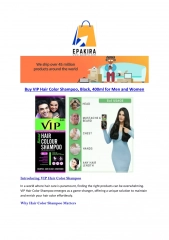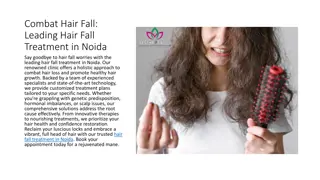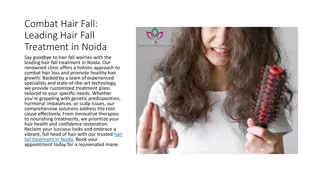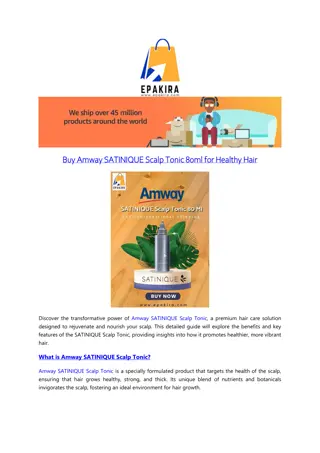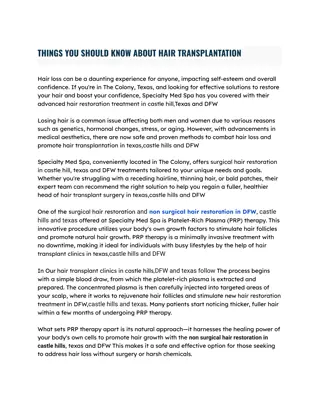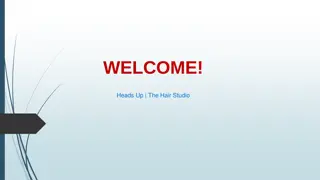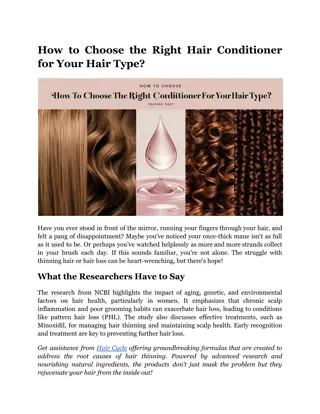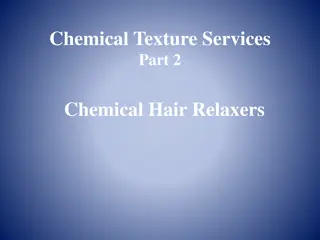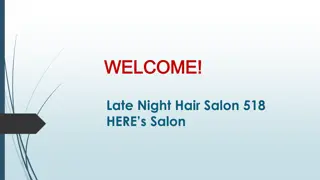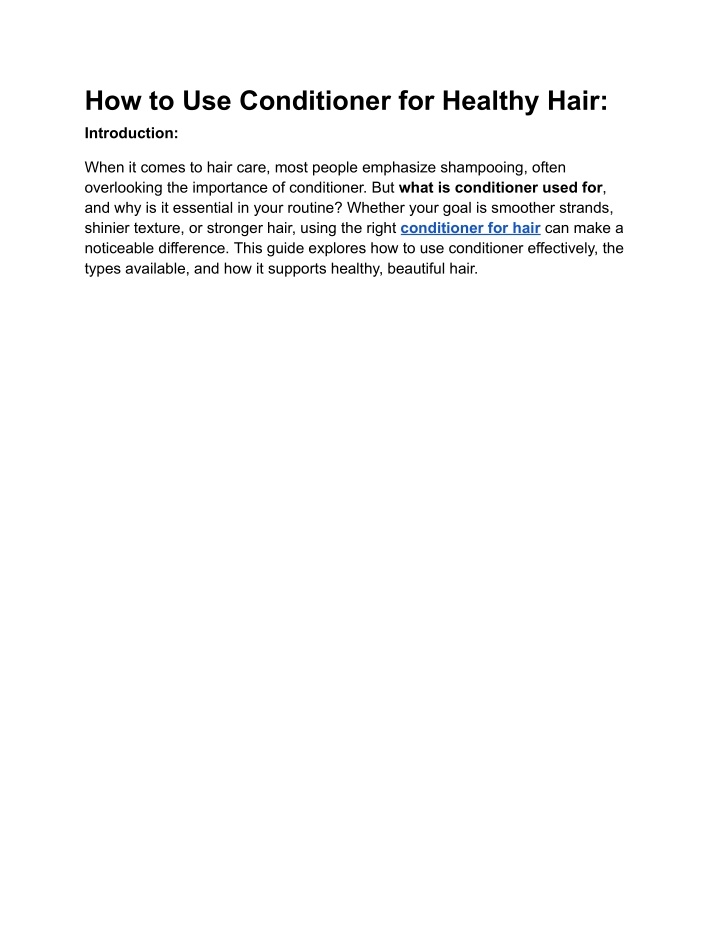
How to Use Conditioner for Healthy Hair
When it comes to hair care, most people emphasize shampooing, often overlooking the importance of conditioner. But what is conditioner used for, and why is it essential in your routine? Whether your goal is smoother strands, shinier texture, or stron
Download Presentation

Please find below an Image/Link to download the presentation.
The content on the website is provided AS IS for your information and personal use only. It may not be sold, licensed, or shared on other websites without obtaining consent from the author. If you encounter any issues during the download, it is possible that the publisher has removed the file from their server.
You are allowed to download the files provided on this website for personal or commercial use, subject to the condition that they are used lawfully. All files are the property of their respective owners.
The content on the website is provided AS IS for your information and personal use only. It may not be sold, licensed, or shared on other websites without obtaining consent from the author.
E N D
Presentation Transcript
How to Use Conditioner for Healthy Hair: Introduction: When it comes to hair care, most people emphasize shampooing, often overlooking the importance of conditioner. But what is conditioner used for, and why is it essential in your routine? Whether your goal is smoother strands, shinier texture, or stronger hair, using the right conditioner for hair can make a noticeable difference. This guide explores how to use conditioner effectively, the types available, and how it supports healthy, beautiful hair.
What Is Conditioner Used For? A hair conditioner is a moisturizing product formulated to improve the feel, manageability, and appearance of hair. It works by restoring moisture stripped away by shampoos, environmental exposure, or heat styling. The answer to what is hair conditioner used for is simple: hydration, repair, shine, and protection. Unlike shampoos that cleanse, conditioners act as protective barriers that lock in moisture and nutrients. They also reduce friction between strands, which minimizes breakage and split ends. Types of Conditioners and Their Unique Benefits There s no one-size-fits-all approach in hair care. From daily use conditioner to targeted formulas like lactic acid hair conditioner, each type offers specific benefits. Here's how to identify which one is best for you: 1. Daily Use Conditioner Ideal for people who wash their hair frequently, a daily use conditioner offers lightweight moisture without weighing the hair down. These are typically suitable for normal to oily hair types and help maintain softness and manageability. 2. Strength Conditioner A strength conditioner or stregnth conditioner is infused with proteins and amino acids that repair weak or damaged strands. It s the perfect solution for chemically treated or heat-styled hair that needs structural support. 3. Conditioner for Shine Want that glossy, camera-ready hair? A shine hair conditioner or hair shine conditioner is designed to smooth the hair cuticle, enhancing its ability to reflect light. This gives your hair a silky, luminous finish. 4. Lactic Acid Hair Conditioner Lactic acid is known for its exfoliating and hydrating properties. A lactic acid hair conditioner gently removes dead skin cells from the scalp while deeply moisturizing the hair. It s a great option for people dealing with dullness or buildup
How to Use Conditioner Properly for Best Results Knowing what conditioner is used for is only half the story. Proper usage is key to unlocking its full benefits. Here s a step-by-step guide: Step 1: Shampoo Your Hair Always apply conditioner after cleansing your scalp with a mild shampoo. This prepares the hair shaft to absorb the conditioning ingredients more effectively. Step 2: Squeeze Out Excess Water Too much water can dilute the conditioner. Gently squeeze out the extra moisture from your hair before application. Step 3: Apply from Mid-Length to Ends Focus the conditioner on the mid-lengths and ends of your hair the most fragile and dry parts. Avoid applying too much on the scalp to prevent build-up and greasiness. Step 4: Let It Sit Let the conditioner rest for 2 5 minutes depending on the instructions and your hair needs. This allows active ingredients like proteins, oils, and acids to penetrate the hair shaft. Step 5: Rinse Thoroughly Use lukewarm or cool water to rinse. This helps seal the hair cuticle, locking in shine and moisture. Tips to Maximize Your Conditioner s Benefits To make your conditioner for hair more effective, follow these expert tips: Use a wide-tooth comb while the conditioner is in to detangle hair and ensure even distribution. Deep condition once a week if your hair is very dry or damaged. Alternate between formulas for example, use a strength conditioner once or twice a week along with your daily conditioner.
Avoid silicone-heavy products if your hair feels weighed down or greasy quickly. Common Myths About Hair Conditioner Understanding what is hair conditioner used for also means busting common myths. Let s clear the air: Myth 1: Conditioner causes hair fall. Truth: Conditioner actually strengthens hair by reducing breakage. It doesn t affect hair growth or hair fall from the roots. Myth 2: Only dry hair needs conditioner. Truth: Even oily hair benefits from lightweight conditioning to balance moisture and improve texture. Myth 3: You don t need conditioner if you use hair masks. Truth: Hair masks are for deep treatment. Conditioners are for everyday moisture and should not be skipped. Choosing the Right Conditioner for Your Hair Type Selecting the right conditinor (or conditioner, as commonly misspelled) depends on your hair type and specific concerns: Dry or Damaged Hair: Opt for a strength conditioner or rich formula with keratin or lactic acid. Frizzy or Dull Hair: Look for a conditioner for shine with argan oil or vitamin E. Fine or Oily Hair: Use a daily use conditioner that is silicone-free and lightweight. Color-Treated Hair: Choose a sulfate-free hair conditioner that preserves color while nourishing the strands. Conditioner Application Mistakes to Avoid To make the most of your condioner, avoid these common mistakes: Applying too much product: It can lead to buildup, making your hair limp and oily.
Skipping rinsing: Leftover conditioner can attract dirt and oil. Using hot water to rinse: This opens up the hair cuticle, leading to moisture loss. Using body lotion or oils as substitutes: These can clog the scalp and lead to hair issues. Why Conditioner Should Be a Non-Negotiable Part of Your Routine In conclusion, understanding what is conditioner used for helps you prioritize it as an essential element of your hair care routine. From softening and strengthening to enhancing shine and reducing damage, the right hair conditioner transforms your hair from ordinary to radiant. Regular use of the appropriate conditioner for hair not only improves your hair s look but also its long-term health. So whether you re opting for a shine hair conditioner, a strength conditioner, or experimenting with the benefits of a lactic acid hair conditioner, make it a habit to condition smartly your hair will thank you for it.

